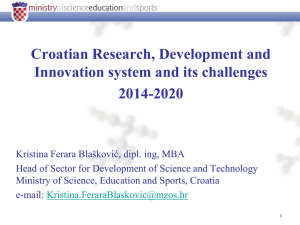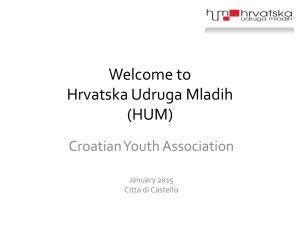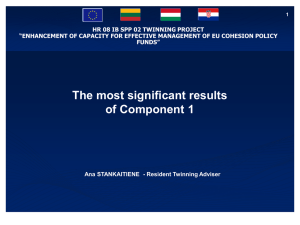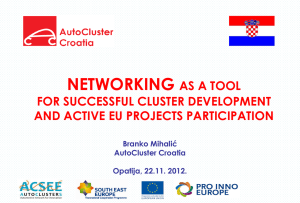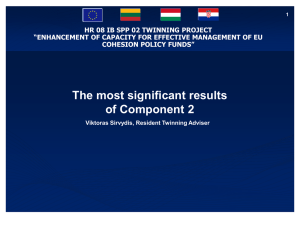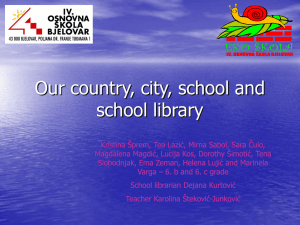In Slovenia
advertisement
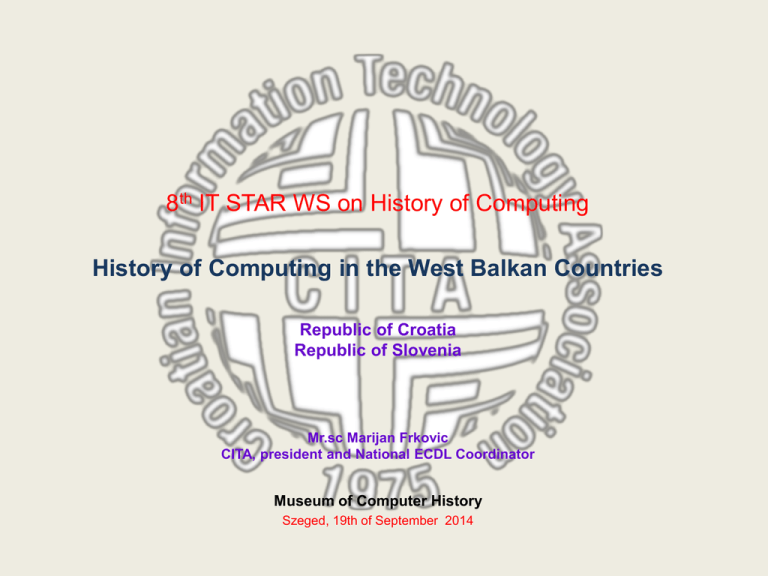
8th IT STAR WS on History of Computing History of Computing in the West Balkan Countries Republic of Croatia Republic of Slovenia Mr.sc Marijan Frkovic CITA, president and National ECDL Coordinator Museum of Computer History Szeged, 19th of September 2014 CROATIAN IT ASSOCIATION (CITA) CITA (www.hiz.hr) is the umbrella organization of Croatian ICT experts founded in 1975, ever since it has been acting continuously CITA participates in the work of international ICT associations of informatics experts; ITSTAR (www.starbus.org), CEPIS (www.cepis.org) and IFIP (www.ifip.org). CITA has ECDL license (www.ecdl.hr), and license for the certification of professional ICT experts www.eucip.hr) in Croatia.. CITA AND IT STAR • Member from 2002 • CITA and IT STAR organized regional conference on e-business held in Zagreb on 2010, where it was opportunity to exchange experiences of e-business in the countries of Central and Eastern Europe (www.starbus.org/ws5/ws5.htm). CITA i their Organisation and Forums Croatian Society for Open Systems and Internet, founded 1992 Croatian ORACLE User Group, founded 1995 Croatian Society of Young Informaticians, founded 1985 Croatian Linux Users Group, founded 1996 Croatian Society of Geographic IS, founded 1994 Croatian Society of SAP, founded 1996 Croatian Society of ECDL test, founded 2003 Marijan Frkovic, CV Active in informatics for more than 46 years having spent 24 years in a large steel company (13.000 employees) and 18 years in Croatian Chamber of Commerce 1968 - Programmer (UNIVAC 1004) II-nd generation, with external programing 1970 - Programmer and system analist (UNIVAC 1106) 1975 - Main system programmer and DB administrator 1982 - Project department leader 1983 - Computer centre director 1986 - Member of the Business Board of Stell Corporation for informatics (UNISYS 1100/72) 1992 - Director of Informatics department in Croatian Chamber of Commerce (UNISYS 80) 1993 - Member of the WG in ICC Paris for development World Chambers Network ( result 10.000 Chambers on the Net, Worldwide) 2005 - Member of the WG in ICC Paris for development e-business 2010 - Retired 1994 – 2002 President of CITA 2002 – 2011 Vice president and National ECDL coordinator 2011 – President of CITA Balkan Countries West Balkans Countries History of Computing in the former Yugoslavia Countries of the former Yugoslavia There were no political barriers to import computer equipment from the West, which significantly influenced faster development of information systems and professional trainings of computer programmers. Yugoslavia - Open computers market Open market had a negative influence on the development of computing in Croatia because users were buying computers mainly from abroad. Installed computers in the Yugoslavia, 1988 Computer APPLE ALEGON-QUME BULL BURROUGHS BUNKER RAMO BYTRONIX CBM CDC COMPUTER COMMODORE CONTROL CII CROMEMCO DARO DATA GENERAL DEC DFE DIGISET DIGITAL DIGITRON BUJE EI HONEYWELL EI NIS EI KIENZLE ELWRO EMOK EPSON Total Very Small Small Medium Large 337 400 4 533 199 1 4 21 1 622 7 4 18 62 1 29 1 1 189 7 460 13 159 3 8 51 337 400 _ 181 199 1 4 12 1 601 5 _ 16 59 _ 1 1 1 41 6 319 13 139 2 _ 51 _ _ 4 291 _ _ _ 8 _ 18 _ 4 2 3 1 14 _ _ 69 1 114 _ 17 1 5 _ _ _ _ 59 _ _ _ _ _ 3 _ _ _ _ _ 11 _ _ 74 _ 15 _ 3 _ 3 _ _ _ _ 2 _ _ _ 1 _ _ 2 _ _ _ 3 _ _ 5 _ 12 _ _ _ _ _ Very small - up to 10.000 $ Smal l- 10.000 – 50.000 $ Medium - 50.000 – 500.000 $ Large - more than 500.000 $ Installed computers in the Yugoslavia, 1988 FUJITSU GENERAL GCS HELWETT PACKARD HITACHI HONEYWELL HUGIN IBM ICL INFOREX INFOSISTEM IRIS ISKRA IVASIM JAVOR BITOLA KIENZLE KOPA LITTON LOGABAX MEAL MAI MDS MERA MICOS Total 31 2 2 Very small 5 1 1 Small 14 1 1 Medium 11 _ _ Large 1 _ _ 552 1 198 9 8447 182 17 15 209 1759 217 418 1 35 9 7699 49 12 15 197 1146 217 106 _ 129 _ 410 110 1 _ 12 306 _ 27 _ 23 _ 233 15 4 _ _ 303 _ 1 _ 11 _ 105 8 _ _ _ 4 _ 35 229 37 1 3 67 15 388 16 30 159 18 1 3 58 14 355 15 5 66 16 _ _ 9 _ 18 1 _ 4 3 _ _ _ 1 15 _ _ _ _ _ _ _ _ _ _ 25 1 24 _ _ Installed computers in the Yugoslavia, 1988 MRI NCR NIXDORF NOVKABEL OLIVETTI ORIC NOVA PEL VARAZDIN PERTEC PHILIPS RAVI RGB ROBOTRON RUF RIZ SDP SIMENS SINGER SPERRY TEHNICAR TEKTRONIX TIM TOVARNA MERIL KOPA TRIUMPHADLER TRS Total 2 303 43 48 1113 35 Very small 2 200 18 5 1037 30 Small _ 76 22 42 75 5 Medium _ 26 3 1 _ _ Large _ 1 _ _ _ _ 65 6 28 5 402 91 15 140 1 1 3 353 188 11 280 65 4 28 5 399 86 15 135 _ 1 2 300 188 3 237 _ 2 _ _ 3 3 _ 4 1 _ _ 27 _ 8 36 _ _ _ _ _ 2 _ 1 _ _ 1 16 _ _ 7 _ _ _ _ _ _ _ _ _ _ _ 20 _ _ _ 10 6 3 1 _ 13 226 13 213 _ 13 _ _ _ _ Installed computers in the Yugoslavia, 1980 UNIVAC VARIAN VIDEOTON WANG OTHERS Total Total 32 7 34 14 Very small 7 1 11 11 Small 8 6 20 3 Medium 13 _ 3 _ Large 4 _ _ _ 822 744 63 14 1 Source: Yugoslav IT Association, 1989 Installed computers in the Yugoslavia, 1988 Republic Number of Computers % Slovenia 9,400 47,27 Croatia 5,682 28,60 Serbia 3,565 17,92 Bosnia&Herzegovina 769 3,86 Macedonia 409 2,05 Montenegro 55 0,27 19,883 100,00 Total Source: Yugoslav IT Association, 1989 Installed computers in Croatia in the 1985th to 1989th Year Very small Small Medium Large 1985 1566 1025 104 22 1987 4098 3154 129 48 1988 5020 3857 166 51 1989 6582 5300 2010 72 Source: Croatian IT Association, 1990 History of Computing in the former Yugoslavia On the begining, computer used in nuclear instituts for atomic weapons research. No data about it.. Instituts Vinca, Beograd Serbia, 1948 Rudjer Boskovic, Zagreb Croatia, 1949 Jozef Stefan, Ljubljana Slovenia, 1949 History of Computing in the former Yugoslavia The history of computing in in the former Yugoslavia can be divided into three periods: before 1965s, 1965s to 1975s, and after 1975s. History of Computing in the former Croatia – Before 1965 The development and manufacture of computers started in 1948 when Computing machinery factory Zagreb – (TRS ) was set up, the first of its kind in Croatia. At the beginning, the factory computers. produced mechanical History of Computing in Croatia - Before 1965 First digital computer in Croatia, 1959 Professor Branko Soucek, PhD Institut "Rudjer Boskovic„ Zagreb, Initiator and the one who built the first digital computer in Croatia was a Croatian scientist, the doyen of computer science, both in Croatia and worldwide, professor Branko Soucek, Beginning of computer science development in Croatia. First digital computer in Croatia, 1959 First computer analyzer, called "256-channel memory, logics and programs": based on vacuum tubes, the magnetic cores memory, speed of million cycles p/s, which was incredible at that time. Cathode tube was used as an output unit to display the data. Croatia - Before 1965 Business computer • Usage of computers and the development of IS started it was based mainly on imported equipment. • Due to high price, only large organizations could buy computers. • Although the equipment had limited capacity, highly trained staff could develop complete applications, thus compensating for limited capacities. UNIVAC 1004/USA Croatia - Before 1965 Characteristics • Plug-board programmed, punched card data introduced in 1962, core memory 961 characters (6 bits) Peripherals • card reader (400 cards/minute), card punch (200 cards/minute) using 90-column, cards • drum printer (400 lines/minute) • Plug-board UNIVAC 1004 Croatia - From 1965 to 1975 Unfortunately Unfortunately, we were young and we did not think that this equipment should be preserved. This (large size) computers and all equipment used later (large scale computers) ended up in the steelworks. Steelworks Croatia - From 1965 to 1975 Local production • • • During 1968 , the first electronic calculator with optical display was developed. The calculator was based on 100 10-component integrated circuits produced in the factory RIZ in Croatia. At that time, there were no LSI or VLSI-chips in the world, as well as integrated circuits of high and very high degree of integration. Calculators Croatia - From 1965 to 1975 System 1 Colaboration with Slovenia TRS collaborated with the company MDS and Metalka from Ljubljana in the production computers as of well 711 as series with the company IBM in the production of Series i and System 1, equipped with peripherals from Croatia, intended for use in economy, schools, railway and others. Croatia - From 1965 to 1975 3rd generation • real time applications, , communication systems, • databases, • multiprogramming, which enabled, the faster processing units and larger storage of external memories, the development of IIS UNIVAC 1106/USA Croatia - From 1965 to 1975 4rd generation • Main companies were IBM, UNIVAC, ICL, Burroughs , BULL GAMMA, Honeywell, PDP and others. UNIVAC 1100/72 Croatia - From 1965 to 1975 During 1974 there was an idea that the development of computer equipment production in Croatia can progress in collaboration with only foreign partner - technologically developed and well off. Therefore, in 1976 the Government of the Republic of Croatia supported this initiative, so the Government contacted the companies ICL and SPERRY UNIVAC. Croatia - From 1965 to 1975 In other parts of Yugoslavia the contacts were established as well, • Slovenia with Philips, • Serbia with Olivetti and Rockwell, • Bosnia and Herzegovina with NCR and Olympia Croatia - From 1965 to 1975 New studies Computer science and Digital computers • In 1970 at the Faculty of Electrical Engineering and Faculty (FEE) of Science Zagreb were the first in Croatia introduced new study for undergraduate students in the 3rd and 4th year of the study: Computer science, and for the postgraduate study • 1970 introduced new college: Digital computers, too After 1975 Local Production • Couple of Croatian companies that produce the equipment for process management in telephone exchange, CAD CAM systems and graphics workstation, personal computers and peripherals (printers, cash registers, video terminals, discs) etc. • With open market, production of hardware in Croatia developed more slowly. After 1975 • In Croatia there were leading foreign manufacturers of computer equipment, IBM, SPERRY UNIVAC ( UNISYS) and others, who continued their work by installing computers of great capacities, • Developing IS with the support of highly trained croatian experts, which later resulted, after 1990 in establishing private IT companies that positioned well in the foreign market. After 1975 • Development of Croatian software and network accelerated, as result • Well educated of ICT professionals • Possibilities of buying hardware and software from abroad • Possibilities of more productive collaboration with the foreign • partners. After 1975 Croatia could not compete with the world in the development of hardware and system software, but the experience and knowledge of our experts used in the development of application software Museum of the old small computers and IT opened 2007 PEEK&POKE Club/Computer museum Rijeka Several hundred computers and more than the thousand calculators Very early calculators and game consoles to rare and obsolete computers from the nineties. Still had survived A Brief History of Computing in Slovenia • Overview • Before 1965 • 1965 to 1975 • After 1975 • Present Slovenia - Before 1965 Computers are a new phenomenon with a poor understanding of their potential worldwide The same is true of Slovenia of that era Main calculating aids were electromechanical devices and slide rule However There was an awareness that electronic computers might be useful in scientific and technical domain. As a result, Zuse 23 computer has been bought and installed as early as 1962. Its usage: - Physics - - statistics - - extensive calculations in engineering (e.g. statics) However, it was still in function in 1967 and deployed to calculate score in 1967 European Figure Skating Championship in Ljubljana Slovenia - 1965 to 1975 Highlights In the world computers are recognized as a tool to enhance efficiency and productivity of commercial companies. Computers are recognized as a useful tool in public administration In Slovenia Major computer companies are represented: UNIVAC, National Cash Register, RCA, General Electric, Control Data Corporation, Honeywell, Burroughs, Digital Equipment Corporation, Olivetti and more First IBM Training Centre is established in Radovljica Major companies and administrative bodies start to establish data processing departments No own production of computers or peripherals yet. Slovenia - After 1975 Highlights Computers are here to stay as inevitable tools in all industries and activities Minicomputers start taking over the role of mainframes New concepts in computing: - distributed computing - cooperative computing - client – server scheme - computer networks In Slovenia Iskra Delta is established Development of Triglav/Trident – a most advanced personal computer of the time Start of “own“ production - Delta 340 Development of IBM-compatible application programs However In the late 1980s Iskra Delta dissolved, end of Slovenian computer production Slovenia - Present Highlights Ubiquitous computer and computing Internet Intelligent devices Mobile computing Social networks Massive data processing Need of computer skills recognized In Slovenia No own computer production Thousands of companies active in software development and providing related services Niche software products Bottom line: not to produce or own, but use intelligently Thank you • • • • • • Marijan Frkovic Croatian IT Association Prezident e-mail: marijan.frkovic@hiz.hr 10000 Zagreb, Ilica 191e CROATIA www.hiz.hr, www.ecdl.hr
